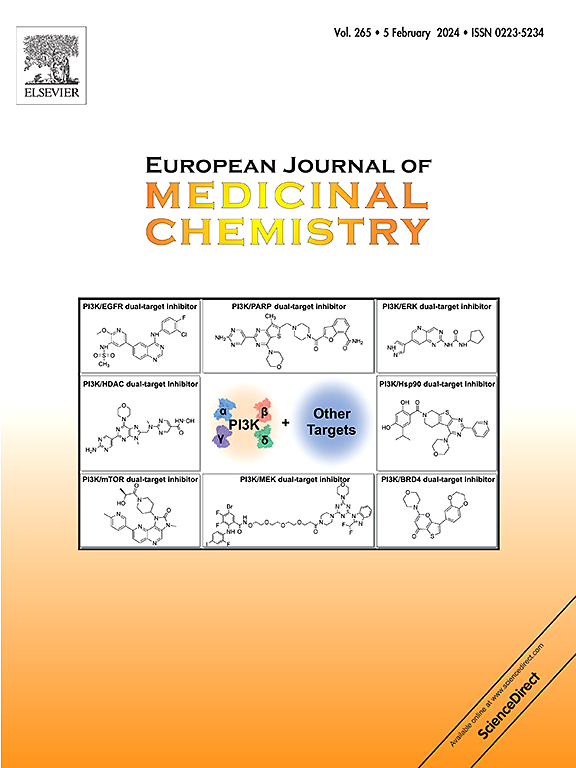以片段为基础合理设计针对 HRP 家族 PWWP 结构域的化合物
IF 6
2区 医学
Q1 CHEMISTRY, MEDICINAL
引用次数: 0
摘要
鳞状上皮源性生长因子 p75(LEDGF/p75)是肝癌源性生长因子相关蛋白(HRP)家族的成员,是一种转录共激活因子,参与多种病症的治疗,包括艾滋病病毒感染和恶性肿瘤(如 MLL 重组白血病)。LEDGF/p75 通过其整合酶结合结构域将蛋白质拴系在染色质上。这种染色质相互作用发生在 LEDGF/p75 的 PWWP 结构域和带有组蛋白 H3 Lys36 二甲基化或三甲基化标记(H3K36me2/3)的核小体之间。我们的目标是合理地设计出能够抑制这种相互作用的小分子药物。为了引导这一发展,我们采用了基于 X 射线晶体学的片段筛选(FBS-X)。鉴于 LEDGF PWWP 结构域晶体不适合用于 FBS-X,我们采用了与之密切相关的同源物 HRP-2 的 PWWP 结构域晶体。结果,我们发现了多达 68 个不同的片段,提供了 H3K36me2/3 口袋药理的详细样本。通过 X 射线晶体学、核磁共振和差示扫描荧光测定法的验证,随后在三个方向上进行的结构引导片段扩展产生了多个与口袋结合的化合物系列。我们的最佳化合物具有两位数的微摩尔亲和力,并对口袋中可用的相互作用进行了最佳采样,根据基于 Kd 的配体效率判断,每个非氢原子的配体效率超过 0.5 kcal/mol。除了口袋芳香笼内的π堆叠和氢键作用外,最佳化合物还参与了卤原子与埋藏在口袋深处的保守水之间的σ-孔相互作用。值得注意的是,与 NSD2 和 NSD3 的相关 PWWP1 结构域相比,LEDGF PWWP 的结合口袋要小得多。LEDGF PWWP 中缺少这个子口袋限制了可达到的亲和力。此外,H3K36me2/3 口袋在整个 PWWP 结构域家族中的这些结构差异转化成了我们开发的化合物的独特选择性。排名靠前的化合物能与同源的 LEDGF 和 HRP-2 PWWP 结构域相互作用,但它们对属于其他 PWWP 结构域亚家族的 NSD2 PWWP1 和 BRPF2 PWWP 结构域没有亲和力。尽管如此,我们开发的化合物系列还是为未来以 LEDGF PWWP 结构域为靶点的药物研发奠定了坚实的基础,因为这些化合物还可以通过组合化学的方法进行进一步的研究。鉴于H3K36me2/3核小体与LEDGF/p75的亲和力是由口袋内的相互作用以及与DNA结合残基的相互作用驱动的,我们建议未来的化合物开发也应以DNA结合残基为目标。除了药物发现,我们的化合物还可用于设计工具化合物,以研究 LEDGF/p75 在表观遗传调控中的作用机制。本文章由计算机程序翻译,如有差异,请以英文原文为准。

Rational fragment-based design of compounds targeting the PWWP domain of the HRP family
Lens epithelium-derived growth factor p75 (LEDGF/p75), member of the hepatoma-derived growth-factor-related protein (HRP) family, is a transcriptional co-activator and involved in several pathologies including HIV infection and malignancies such as MLL-rearranged leukemia. LEDGF/p75 acts by tethering proteins to the chromatin through its integrase binding domain. This chromatin interaction occurs between the PWWP domain of LEDGF/p75 and nucleosomes carrying a di- or trimethylation mark on histone H3 Lys36 (H3K36me2/3). Our aim is to rationally devise small molecule drugs capable of inhibiting such interaction. To bootstrap this development, we resorted to X-ray crystallography-based fragment screening (FBS-X). Given that the LEDGF PWWP domain crystals were not suitable for FBS-X, we employed crystals of the closely related PWWP domain of paralog HRP-2. As a result, as many as 68 diverse fragment hits were identified, providing a detailed sampling of the H3K36me2/3 pocket pharmacophore. Subsequent structure-guided fragment expansion in three directions yielded multiple compound series binding to the pocket, as verified through X-ray crystallography, nuclear magnetic resonance and differential scanning fluorimetry. Our best compounds have double-digit micromolar affinity and optimally sample the interactions available in the pocket, judging by the Kd-based ligand efficiency exceeding 0.5 kcal/mol per non-hydrogen atom. Beyond π-stacking within the aromatic cage of the pocket and hydrogen bonding, the best compounds engage in a σ-hole interaction between a halogen atom and a conserved water buried deep in the pocket. Notably, the binding pocket in LEDGF PWWP is considerably smaller compared to the related PWWP1 domains of NSD2 and NSD3 which feature an additional subpocket and for which nanomolar affinity compounds have been developed recently. The absence of this subpocket in LEDGF PWWP limits the attainable affinity. Additionally, these structural differences in the H3K36me2/3 pocket across the PWWP domain family translate into a distinct selectivity of the compounds we developed. Our top ranked compounds are interacting with both homologous LEDGF and HRP-2 PWWP domains, yet they showed no affinity for the NSD2 PWWP1 and BRPF2 PWWP domains which belong to other PWWP domain subfamilies. Nevertheless, our developed compound series provide a strong foundation for future drug discovery targeting the LEDGF PWWP domain as they can further be explored through combinatorial chemistry. Given that the affinity of H3K36me2/3 nucleosomes to LEDGF/p75 is driven by interactions within the pocket as well as with the DNA-binding residues, we suggest that future compound development should target the latter region as well. Beyond drug discovery, our compounds can be employed to devise tool compounds to investigate the mechanism of LEDGF/p75 in epigenetic regulation.
求助全文
通过发布文献求助,成功后即可免费获取论文全文。
去求助
来源期刊
CiteScore
11.70
自引率
9.00%
发文量
863
审稿时长
29 days
期刊介绍:
The European Journal of Medicinal Chemistry is a global journal that publishes studies on all aspects of medicinal chemistry. It provides a medium for publication of original papers and also welcomes critical review papers.
A typical paper would report on the organic synthesis, characterization and pharmacological evaluation of compounds. Other topics of interest are drug design, QSAR, molecular modeling, drug-receptor interactions, molecular aspects of drug metabolism, prodrug synthesis and drug targeting. The journal expects manuscripts to present the rational for a study, provide insight into the design of compounds or understanding of mechanism, or clarify the targets.

 求助内容:
求助内容: 应助结果提醒方式:
应助结果提醒方式:


